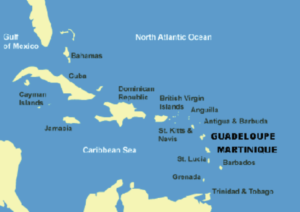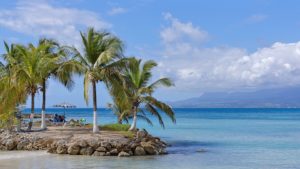 Jews were first recorded living in Guadeloupe in the late 14th century. In 1391, in a surge of anti-Jewish riots that began in Spain, where most of the Jews were murdered. The community, however, began to revive during the mid-15th century. In 1485, the local inquisitor, Nuño de Arévalo, forbid all Jews from living in Guadeloupe. Prior to the expulsion of the Jews from Spain and Portugal in 1492, the Jewish community sold the land of the old cemetery to the local bishop, for the sum of 400 reals; a clause in the deed of sale states that the price was so low because of the kindnesses shown to the Jewish community by the bishop. Many Jews were forced into converting to Christianity; the Conversos in Guadeloupe lived together in a specified street in the former Jewish quarter. In 1489, two monks Diego de Marchena and García Capata, were burned at the stake for converting to Judaism.
Jews were first recorded living in Guadeloupe in the late 14th century. In 1391, in a surge of anti-Jewish riots that began in Spain, where most of the Jews were murdered. The community, however, began to revive during the mid-15th century. In 1485, the local inquisitor, Nuño de Arévalo, forbid all Jews from living in Guadeloupe. Prior to the expulsion of the Jews from Spain and Portugal in 1492, the Jewish community sold the land of the old cemetery to the local bishop, for the sum of 400 reals; a clause in the deed of sale states that the price was so low because of the kindnesses shown to the Jewish community by the bishop. Many Jews were forced into converting to Christianity; the Conversos in Guadeloupe lived together in a specified street in the former Jewish quarter. In 1489, two monks Diego de Marchena and García Capata, were burned at the stake for converting to Judaism.
In 1654, three shiploads of Jewish refugees from Brazil settled in Guadeloupe. During that time, the Jews were welcomed by the French owner of the island. Even the capital of Guadalupe, Pointe-a-Pitre was named after a Brazilian Jew, called Pietre who started a fish processing plant in the city. The Jews established sugarcane plantations, which ultimately became the country’s leading export. In 1685, however, King Louis XIV issued “The Black Code” taking away the land rights of all Jews from Guadeloupe and enforcing catholicism or expulsion.
 When a ship carrying Jews anchored not far from Martinique, Governor M. du Parquet was inclined to grant their request to settle on the island. The Jesuit fathers residing on Martinique would not hear of it. The governor of Guadeloupe, M. Houel, learning of the refusal to allow the refugees to settle in Martinique, welcomed them to settle on his island. Many former Jewish inhabitants of Tamarica, Brazil, an island not far from Recife, were allowed to settle on Guadeloupe.
When a ship carrying Jews anchored not far from Martinique, Governor M. du Parquet was inclined to grant their request to settle on the island. The Jesuit fathers residing on Martinique would not hear of it. The governor of Guadeloupe, M. Houel, learning of the refusal to allow the refugees to settle in Martinique, welcomed them to settle on his island. Many former Jewish inhabitants of Tamarica, Brazil, an island not far from Recife, were allowed to settle on Guadeloupe.
They were granted the same privileges as the other residents of the island. These Jews were wealthy and it was expected that the new arrivals would spend lots of silver and gold as they established themselves in their new home. The Jews, immediately after settling, began to establish commercial houses, sugar cane plantations, and sugar plants on a large scale. This brought a period of prosperity to the impoverished islands and profits to Houel. After the French Revolution many Jews left.
After the second abolition of slavery in 1840, some Cochin Jews arrived from the Indian subcontinent under contract to work on the sugar plantations. They didn’t have
much choice as to what they could bring in a small baggage, so they brought the seeds of what they loved the most, tropical fruits and veggies. Eventually they all became French citizens with equal rights.
During the latter part of the 20th century, many Jews began to arrive from Morocco, Algeria and France. By 1959, there were around 100 Jews. In 1988, the Jewish community consecrated the first synagogue in Guadeloupe – Or Sameah. Later the congregation added a Talmud Torah, community center, kosher store, and Jewish cemetery. The membership in 2010 was around 150 families.